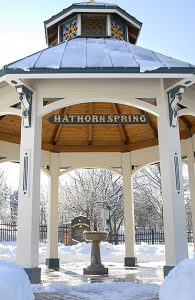
©2017 Saratoga Photographer.com
By Maureen Werther
As a lifelong resident of Saratoga Springs, Charlie Kuenzel recalls his childhood, when everyone had a deep understanding of and appreciation for the city’s history and the role the famous mineral springs played in making the city a famous destination.
People seeking health, wellness and perhaps even the fountain of youth sought out the springs in year gone by.
Long before the race horses, the high-rollers and the wealthy elite, the bubbling waters that spouted from the ground were revered by the Mohawk Native American tribe, who believed they had restorative and healing qualities. Today, scores of people continue to visit the springs each week, filling bottles and jugs with water to use in a variety of ways.
Some waters are consumed, while others are used topically as a curative. Proponents of the waters attest to their restorative, revitalizing and healing powers, and different springs are used for issues ranging from intestinal discomfort to acne.
Kuenzel, co-owner of Saratoga Tours and a member of the board of trustees of the Saratoga Springs History Museum, cautions that there are no medical studies that claim the waters can “heal.”
But he said there had to have been some good reasons why the Mohawks would journey to Saratoga each summer for hundreds of years, living by the springs throughout the warm months and bringing it back with them to their encampments for the long winters.
Kuenzel has become an expert on the history of the springs. He is a retired high school science teacher and runs Saratoga Tours with business partner,David Patterson. The pair have been giving tours of the city for nearly 20 years.
One of Kuenzel’s undergraduate degrees is in geology, which interested him from the time he was a teen. The geology of the area held particular interest for him, and he calls the set of circumstances that went into the formation of the springs a “perfect storm.”
A combination of limestone and shale, as well as a “normal” geological fault caused water to become trapped in the layers of limestone which were capped by the solid shale. The fault created cracks and fissures through which the waters sprung upward, he said.
The natural carbonation of the water is a result of minerals from the limestone being dissolved. According to literature on the springs, the waters found in Saratoga are unique to this part of the country because of their natural carbonation, their constant 55-degree Fahrenheit temperature, and their “spouting” properties.
Kuenzel said there were three “original” sources of spring water where it naturally bubbled to the surface. The spring located on what is now High Rock was, he said, the “real reason” the Mohawks came to Saratoga.
They referred to it as “the spring of the great spirit” or “the great medicine spring,” according to Kuenzel. “The name ‘Saratoga’ itself is a Mohawk term, meaning the hillside of the great river,” added Kuenzel.
The second great spring is located in Congress Park and was discovered by Nicholas Gilman, who was a congressman from New Hampshire. It eventually became the most famous of the springs and the water was bottled and sold around the world.
The third spring, known as “Old Red Spring,” became known for its ability to cure skin disorders, and it is still referred to as the Beauty Spring or Beauty Water.
There are many more springs located throughout the city proper and the surrounding areas, each with different “healing” properties, he said.
Kuenzel recalled going to play with friends at their homes and drinking the mineral water on a daily basis. For children of a certain era, it was their “juice boxes.”
“Our mothers would send us on play dates with mineral water. We all drank it. We were raised on it,” he said.
Kuenzel said his own children were raised drinking mineral water or using it as a topical substance.
One question that Kuenzel gets often during his tours is, “Do people in this area live longer?”
“I don’t have an answer to that,” he said. But he recalls a tour group of ophthalmologists, who said that the elevated level of zinc found in the springs work to reduce the formation of cataracts.
Kuenzel commented again about the Mohawks. “I don’t think any indigenous group of people would waste their time traveling here if they did not think the waters had a curative power.”
